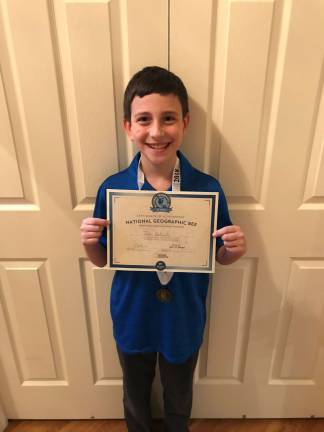Sparta 6th-grader will compete in statewide geography bee

By Rose Sgarlato
SPARTA — Sixth grader Ian Bellush’s early love of almanacs is paying off.
The Sparta Middle School student is one of 100 semifinalists eligible to compete in the 2018 New Jersey National Geographic State Bee at Rowan University on Friday, April 6.
Ian’s started his National Geographic Bee journey earlier this year on Jan. 12 when he won the top spot at Sparta Middle School’s competition of the 30th Annual National Geographic Bee. From there Ian was eligible to take an on-line qualifying test on Feb.2 for the state finals.
“I started studying for the National Geographic Bee in the beginning of the year, because it’s offered in my STEP classes. I have always loved maps,” said Ian.
His interest in places and locales developed at an early age, added his mother Lorraine Bellush: “He was always reading almanacs and maps when he was younger. He has studied a lot since he heard about it in September. We knew he knew his stuff, but I wasn’t sure a sixth grader would win the school bee.”
School Bees were held in schools with fourth- through eighth-grade students throughout the state to determine each school champion. As how many other New Jersey students Ian beat out to get to the state level, the Education Team at National Geographic Society provided the following reply:
“While we do not give out specific numbers, I can tell you that over 350 schools in New Jersey registered and paid to participate in the 2018 National Geographic Bee, and almost that many had a student take the online Qualifying Test.”
And ian is one of 100 who qualified.
Ian studies about five times a week using guides provided by National Geographic. The qualifying test had 70 questions using a multiple choice format.
“Some had maps,some were industry related,” Ian said. “I think it’s pretty cool that you can find out so much from maps. If a country has a problem, you can relate it to geography.”
One of his favorite locales to study is Asia.
“I really like Asia because of the mountain ranges and all the rivers. The countries are not close in size and they are very different.”
When Ian competes with 99 of his contemporaries on April 6, the test format will be both oral and written with a preliminary round followed by a final round of 10 contenders.
The pressure does not affect him: “I take deep breaths. I am not really nervous. I enjoy the challenge with maps.”
If Ian succeeds on April 6 , he will receive $200, plus a trip to Washington DC to represent New Jersey in the National Geographic Bee Championship May 20-22 at National Geographic Society headquarters
So far, he has not won any prize money.
‘I just want to get in the top 40 or 50,” he said.
All of this geography talk begs the question: Where would Ian want to go if he could choose one place in the whole world?
“Somewhere in Europe. London or Paris maybe," he said. "I would start small. I haven’t been outside the continent.”
How would you fare as a National Geographic Bee contestant? At the school Bees this year, students had to answer questions like these:
1. The Appalachian Mountains run through which state—Georgia or Mississippi?
2. The North Platte and South Platte Rivers meet in which state—New Mexico or Nebraska?
3. Which state straddles the Tropic of Cancer—Hawaii or Alaska?
4. Which form of mass production was used by Henry Ford to produce automobiles in large quantities in Detroit, Michigan—threshing machine or assembly line?
5. What is the term for the physical location where a plant or animal lives—habitat or pattern?
6. Which country does not contain large areas of desert—Chad, Venezuela, or Iraq?
7. Public steam baths called hammams are part of the culture in cities such as Casablanca and Marrakech in which African country?
8. The Delmarva Peninsula includes parts of Delaware, Virginia, and which other state?
9. The easternmost part on the Horn of Africa is located in which country?
10. Angkor Wat, built as a tribute to Hinduism, is located in which Southeast Asian country where Buddhism now predominates?
Answers: 1. Georgia. 2. Nebraska. 3. Hawaii. 4. assembly line. 5. habitat. 6. Venezuela. 7. Morocco. 8. Maryland. 9. Somalia. 10. Cambodia.
The National Geographic Society is a leading nonprofit that invests in bold people and transformative ideas in the fields of exploration, scientific research, storytelling and education. The Society aspires to create a community of change, advancing key insights about the planet and probing some of the most pressing scientific questions of our time, all while ensuring that the next generation is armed with geographic knowledge and global understanding. Its goal is measurable impact: furthering exploration and educating people around the world to inspire solutions for the greater good. For more information, visit <URL destination="http://www.nationalgeographic.org. ">www.nationalgeographic.org.